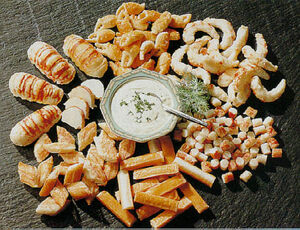About Surimi[]
Surimi is a term meaning formed and referring to fish pulp which has been formed into various shapes. Surimi and the similar Kamaboko have been made for centuries by the Japanese and are thought to date as far back as 1100 A.D. Most surimi found in North America is made from Alaskan pollack, a fish with lean, firm flesh that has a delicate, slightly sweet flavor. Pacific whiting, is also beginning to be used for surimi but its flesh is so soft that it requires the addition of egg whites and potatoes to be firm enough for processing.
To become surimi, fish is skinned, boned, repeatedly rinsed to eliminate any fishiness and pigment and ground into a paste. This odorless white paste is then mixed with a flavor concentrate made from real shellfish, the solution from boiled shells or artificial flavorings. The paste is then formed, cooked and cut into the various shapes of the seafood its imitating, which in the United States is usually crab legs, lobster chunks, shrimp and scallops. Lastly, surimi is colored to complete its transformation from fish to shellfish look-alike.
Surimi is available in the refrigerator or freezer section of most supermarkets. It can be kept unopened in the refrigerator for up to 2 months, in the freezer for up to 6 months. Once opened, use surimi within 3 days. Surimi (which is sometimes simply labeled imitation crabmeat, imitation lobster, etc.) is best when used as an ingredient in salads, casseroles and soups.

